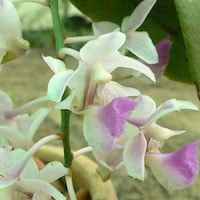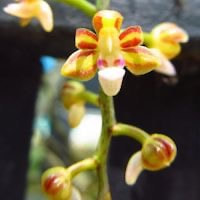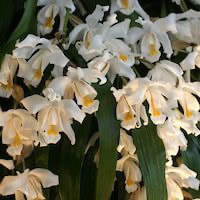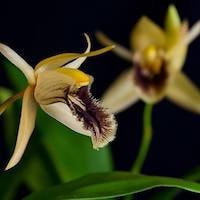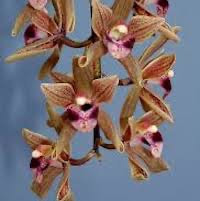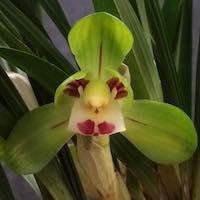MOR2- Men's Oriental 2 - Cigar on a rocking chair
|
Native Singaporean Orchid notes: Cochleanthes Discolor
Cochleanthes Discolor -
Cochleanthes Discolor, known as the "Fan-Shaped Orchid," thrives in Central and South America, preferring warm to cool climates with high humidity and good air circulation. It lacks pseudobulbs and instead grows a fan of leaves. The orchid blooms fragrant flowers from spring through fall, noted for their candy, cedar, pepper, and camphor scents. Although not native to Singapore, it was included in the Oriental 2 (Men) Team Building Perfume Workshop for its captivating fragrance. Orchids like Cochleanthes Discolor are cherished for their beauty and aromatic profiles, making them prized ingredients in perfumery across cultures. Proper care is crucial for their cultivation in non-native environments. |
Therapeutic Orchid notes:
|
Aerides falcata Lindl.
Aerides falcata, also known as Zhijia Lan in Chinese and Ueang Kulaab Krapao Perd in Thai, is a prized orchid species known for its fragrant white flowers arranged in sprays of around 30 blossoms each. It thrives in Thailand, Indochina, and Myanmar but does not extend further south. In Vietnam, it has been traditionally used in medicine; the orchid is believed to tonify and is administered to weak infants for vitality. Additionally, its seeds are applied topically to treat skin conditions like boils. While admired for its beauty and medicinal potential, caution and expert advice are advised before using Aerides falcata or any orchid for medicinal purposes due to safety and dosage considerations. |
|
Cleisostoma tenuifolium (L.) Garay
Cleisostoma tenuifolium, commonly known as delicate leafed Cleisostoma, is an orchid species historically used in traditional medicine in western peninsular India. In traditional herbal practices, various parts of the plant were employed for treating kidney disorders, leucorrhoea, gonorrhoea, and scalds. It was applied externally as a poultice to reduce pain and swelling of abscesses, and mixed with vinegar to treat conditions like kidney stones, dysuria, and menstrual issues. Despite its traditional uses, more scientific research is needed to confirm its medicinal properties, safety, and efficacy. Consultation with healthcare professionals is advised before using Cleisostoma tenuifolium or any herbal medicine. |
|
Coelogyne cristata Lindl. Coelogyne speciosissmum D. Don
Coelogyne cristata, also known as Coelogyne speciosissma, is an orchid species with traditional uses across different regions. Its ethanolic extract shows strong antibacterial effects against Staphylococcus aureus and moderate activity against Escherichia coli. Bioactive compounds like coelogin and coeloginin have been identified, suggesting roles as antimicrobials and plant growth regulators. In India's Kumaon region, it's used for bone fractures in animals, supported by its phytoalexin content. In Myanmar, it treats gastrointestinal issues, and in Nepal, it addresses constipation, acts as an aphrodisiac, and aids wound healing. Despite its traditional uses, further research is needed to confirm its medicinal properties and ensure safe usage. |
|
Coelogyne ovalis Lindl.
Coelogyne ovalis, known as Jeevanti in India and Changlinbeimu Lan in China, is an orchid species with a diverse range of traditional uses and a complex chemical composition. It contains bioactive compounds like coelogin and flavidin, which have shown muscle-relaxing properties in studies. In traditional medicine, it is used as a tonic to promote vitality, and in Nepal, it is regarded as an aphrodisiac. Despite its historical use, further scientific research is needed to confirm its medicinal benefits, proper dosage, safety, and potential interactions with medications. Consulting healthcare professionals before using Coelogyne ovalis or any herbal remedy is recommended for safe usage. |
|
Cymbidium devonianum Paxton
Cymbidium devonianum, known as Fu Lan in China, Thir gava in Nepal, and Gam ngu sac in Vietnam, is an orchid species with widespread distribution across Asia. It thrives on mossy rocks and trees in countries like Nepal, Bhutan, Bangladesh, Myanmar, and others. In Nepali medicine, the root of Cymbidium devonianum is used as a paste to heal boils and brewed into a decoction to treat coughs and colds. Despite its traditional uses, more scientific research is needed to confirm its medicinal benefits, safety, and proper usage, as orchids like Cymbidium devonianum may contain bioactive compounds with potential therapeutic effects. |
|
Cymbidium goeringii (Rchb. f) Rchb. f.
Cymbidium goeringii, also called Chun Lan or Japanese spring orchid, is a widely spread orchid species found in countries like China, Bhutan, India, Korea, and Japan. It grows in stony habitats and sparse forests, blooming from January to March. Known for its delicate floral scent composed of compounds like methyl-cis(z)-dehydrojasmonate and (E) neroldol, C. goeringii is valued in Traditional Chinese Medicine for its roots, which are believed to improve blood flow, cool the blood, and detoxify. It's used to treat various ailments including injuries, lung heat, coughs, and digestive issues. Despite its traditional use, more scientific research is needed to confirm its medicinal benefits and ensure safe usage. |
Other scent note
Scentopia Library Reference ingredient
Poppy - Check details at Scentopia's scent library
Download the guided mediation that works best with this Orchid fragrance oil
| men_oriental_essential_oil_orchi_00002.mp3 | |
| File Size: | 114817 kb |
| File Type: | mp3 |

